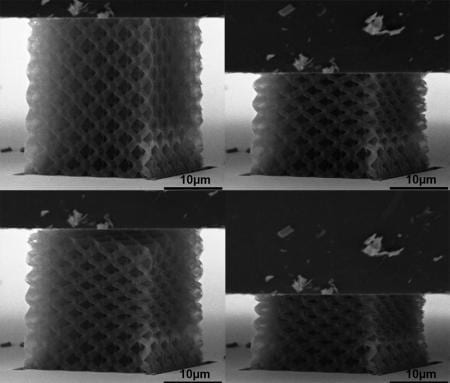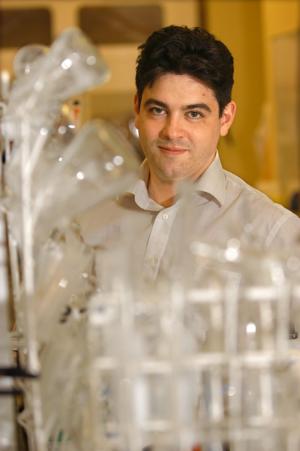
Credit: Lucas Meza/Caltech
Imagine a balloon that could float without using any lighter-than-air gas. Instead, it could simply have all of its air sucked out while maintaining its filled shape.
Such a vacuum balloon, which could help ease the world’s current shortage of helium, can only be made if a new material existed that was strong enough to sustain the pressure generated by forcing out all that air while still being lightweight and flexible.
Caltech materials scientist Julia Greer and her colleagues are on the path to developing such a material and many others that possess unheard-of combinations of properties. For example, they might create a material that is thermally insulating but also extremely lightweight, or one that is simultaneously strong, lightweight, and nonbreakable—properties that are generally thought to be mutually exclusive.
Greer’s team has developed a method for constructing new structural materials by taking advantage of the unusual properties that solids can have at the nanometer scale, where features are measured in billionths of meters. In a paper published in the September 12 issue of the journal Science, the Caltech researchers explain how they used the method to produce a ceramic (e.g., a piece of chalk or a brick) that contains about 99.9 percent air yet is incredibly strong, and that can recover its original shape after being smashed by more than 50 percent.
“Ceramics have always been thought to be heavy and brittle,” says Greer, a professor of materials science and mechanics in the Division of Engineering and Applied Science at Caltech. “We’re showing that in fact, they don’t have to be either. This very clearly demonstrates that if you use the concept of the nanoscale to create structures and then use those nanostructures like LEGO to construct larger materials, you can obtain nearly any set of properties you want. You can create materials by design.”
The Latest on: Nanostructures
[google_news title=”” keyword=”Nanostructures” num_posts=”10″ blurb_length=”0″ show_thumb=”left”]
via Google News
The Latest on: Nanostructures
- SkyWater and Lumotive Announce Qualification and Production Start for World’s First Commercially Available Optical Beamforming Chipon May 1, 2024 at 4:05 am
SkyWater Technology (NASDAQ: SKYT), the trusted technology realization partner, and Lumotive, a pioneer in optical semiconductor technology for 3D sensing, announced today that the companies have ...
- New class of spongy materials can self-assemble into precisely controllable structureson April 30, 2024 at 8:02 am
A team of researchers led by the University of Massachusetts Amherst has drawn inspiration from a wide variety of natural geometric motifs—including those of 12-sided dice and potato chips—in order to ...
- Design strategies toward plasmon-enhanced 2D material photodetectorson April 29, 2024 at 1:28 pm
Traditional semiconductors such as Si, GaAs, and HgCdTe seem unable to meet the development trend of electronic devices that feature ultra-small volume, lightweight, and low power consumption. These ...
- Scientists construct sophisticated synthetic system using self-replicating nanostructureson April 29, 2024 at 7:03 am
A research team led by the late Professor Liang Haojun from the Hefei National Laboratory for Physical Sciences at the Microscale of University of Science and Technology of China (USTC) has developed ...
- New Water Filter Upcycles Cellulose for Cleaner Wateron April 25, 2024 at 9:04 am
Qaisar Maqbool, Study First Author and Postdoc, Institute of Materials Chemistry, Vienna University of Technology This nanocellulose is “spun” with the plastic polyacrylonitrile to create ...
- Flat optics revolutionize quantum light sources for enhanced communication and sensingon April 24, 2024 at 5:00 pm
Flat optical elements, such as metasurfaces, are surfaces patterned with subwavelength-scale nanostructures that can control the amplitude, phase, polarization, and other properties of light. By ...
- Nanofibers Rid Water of Hazardous Dyeson April 24, 2024 at 5:00 pm
This nano-cellulose is "spun" together with the plastic polyacrylonitrile into nanostructures. However, this requires a lot of technical skill. The team from the TU Wien was successful with a ...
- Researchers create nanostructures for efficient and sustainable degradation of pollutantson April 24, 2024 at 9:01 am
The need for sustainable and environment-friendly solutions has accelerated the global demand for green and renewable technologies. In this regard, semiconductor photocatalysts have emerged as an ...
- Novel Au-BiFeO3 nanostructures for efficient and sustainable degradation of pollutantson April 23, 2024 at 5:00 pm
(Nanowerk News) The need for sustainable and environment-friendly solutions has accelerated the global demand for green and renewable technologies. In this regard, semiconductor photocatalysts have ...
- Microscope Market Navigating the Waves Future-Proofing Your Business in a Shifting Marketon April 21, 2024 at 3:56 pm
Request To Download Free Sample of This Strategic Report @- An electron microscope is a scientific imaging instrument that utilizes a beam of accelerated electrons as a source of illumination. As the ...
via Bing News









